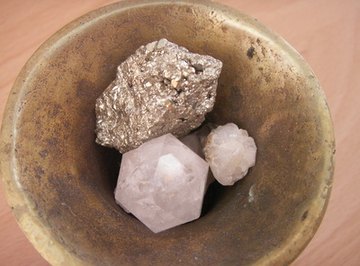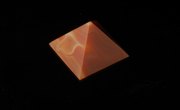
Quartz is one of the most common minerals on Earth. Quartz represents a class of minerals called silicates and is made of silicon dioxide. Some types of quartz crystals are considered semi-precious gemstones. Numerous varieties of quartz exist, with differing properties.
The Formation of Quartz
Quartz is a simple silicate mineral commonly found in the Earth's crust. Quartz is formed in underground solutions rich in silica, and quartz crystals grow in cavities that have enough room.
Quartz may exist in any sedimentary, metamorphic or igneous rock. Quartz crystals are comprised of billions of stacked tetrahedron shapes that build over time into a crystal.
Properties of Quartz
Quartz derives from silicon and oxygen in the compound silicon dioxide, or SiO2. There are many types of quartz crystals, but they all have the same hexagonal crystalline form. Quartz is quite resilient and can endure erosion and other effects weathering. It makes up about 20% of the Earth's crust.
In-depth features of quartz from a gemology standpoint include a density of 2.65 grams per cubic centimeter, a refraction index from 1.54 to 1.55, and a score of 7 on the Mohs hardness scale. This hardness enables quartz to be used as a gemstone.
Pure quartz appears clear in color. Quartz is also piezoelectric, meaning that opposing charges can form on either end of its crystals when subjected to pressure. This makes quartz highly sought after for use in electronics manufacturing.
Types of Quartz Crystals
Many types of quartz crystals exist in nature. Some types of quartz are considered desirable because of their color. These quartz types might also be regarded as semi-precious and of gemstone quality.
Types of quartz crystals include giant quartz, milky quartz, rose quartz, agate quartz, amethyst, smoky quartz (which can be brown, black or yellow), sardonyx quartz, onyx quartz and many other varieties. Impurities lead to the different hues of quartz. Chert, jasper and chalcedony are also forms of quartz.
Cultured quartz is a kind of manufactured quartz without impurities, and it is used for electronics. In making cultured quartz, a bit of natural quartz is used as a seed crystal for the process. From this, the manufactured quartz can grow and be used for industrial purposes.
Where Is Quartz Found?
Because of its hardness and the beautiful nature of certain quartz crystals, you might wonder where quartz can be found. Due to its prevalence in the Earth's crust, it might be easier to find than you realize. However, there are certain regions of the world considered famous for their supply of quartz varieties.
Arkansas (in the United States) is a major producer of quartz, and Brazil is another source of quartz crystals. Additionally, Namibia is an important source of amethyst.
Quartz Throughout History
Humans have used quartz in numerous capacities for thousands of years. In ancient times, people believed quartz had magical properties, and the stones were often used as talismans or were considered anti-aging. Some medieval doctors even thought quartz had healing properties.
The lovely pink hue of rose quartz made it a precious stone for both ancient civilizations and modern ones. Amethyst, the purple-hued varietal of quartz, has long been popular. It can range from pale lavender to deep violet in hue, with zones within its crystals of varying intensity and darkness.
Iris Quartz
One fascinating type of quartz crystal is iris quartz, sometimes called rainbow quartz, anandalite, schiller quartz or adularescent quartz. This quartz can be found in geodes in west-central India.
Iris quartz is famously iridescent, a quality which gives it a rainbow-like sheen. Fine specimens of iris quartz that possess vibrant iridescence can be quite valuable. Upon close microscopic examination, scientists have found that the 'z' faces of the quartz possess what is called a valley-and-ridge structure, as well as surface etching.
Tiger's Eye Quartz
Another interesting variety of quartz is Tiger's Eye quartz. Found in Western Australia, this quartz developed in the sediments of long-extinct seas. Over periods of stress and tectonic activity, this quartz became imbued with fibers of crocidolite as well as iron oxides. This gives Tiger's Eye quartz its gorgeous golden, banded appearance. Popular for beads and necklaces, Tiger's Eye quartz is considered a kind of gemstone.
Quartz-Based Products
Quartz is useful to our modern lives in many ways. Aside from its use as a gemstone, quartz is used in manufacturing. In the steel industry, it comprises silicon-steel alloys. Quartz is also used as a semiconductor because of its silicate properties. Quartz is also used as an anti-caking powder in food and is found in cement, ceramics, fiberglass, lamps and heat-resistant glass.
References
About the Author
J. Dianne Dotson is a science writer with a degree in zoology/ecology and evolutionary biology. She spent nine years working in laboratory and clinical research. A lifelong writer, Dianne is also a content manager and science fiction and fantasy novelist. Dianne features science as well as writing topics on her website, jdiannedotson.com.
Photo Credits
pyrite quartz image by A74.FR Ben Fontaine from Fotolia.com
